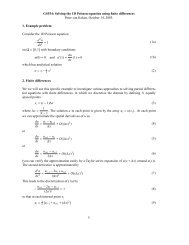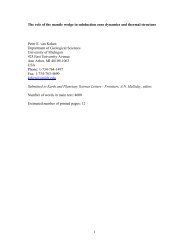Quantitative paleoenvironmental and paleoclimatic reconstruction ...
Quantitative paleoenvironmental and paleoclimatic reconstruction ...
Quantitative paleoenvironmental and paleoclimatic reconstruction ...
Create successful ePaper yourself
Turn your PDF publications into a flip-book with our unique Google optimized e-Paper software.
ARTICLE IN PRESS<br />
18 N.D. Sheldon, N.J. Tabor / Earth-Science Reviews xxx (2009) xxx–xxx<br />
Fig. 11. Quantifying long-term chemical weathering. The values of ΔW shown are based<br />
on the 3-pt. running average of 54 chemical analyses collected from a ~250 m section.<br />
The level of the Eocene–Oligocene transition is known from mammalian<br />
biostratigraphy.<br />
years are preserved (e.g., Sheldon <strong>and</strong> Retallack, 2004; Prochnow<br />
et al., 2006; Retallack, 2007; Sheldon, 2009). By using the same<br />
weathering ratio, measured from the same horizon in comparably<br />
developed paleosols (e.g., all Alfisol-like paleosols), it is possible to<br />
characterize changes in the chemical weathering environment. A new<br />
parameter ΔW can be derived as follows using CIA (Eq. (5)) as the<br />
weathering index:<br />
ΔW = CIA x − μ CIA<br />
ð32Þ<br />
where ΔW is the deviation in weathering for a given paleosol (CIA x )<br />
relative to the mean degree of weathering for the whole sequence<br />
(μ CIA ). Fig. 11 shows how ΔW changed across the Eocene–Oligocene<br />
transition for a relatively poorly dated section in the Ebro Basin<br />
(Spain). Ongoing work by L. Cabrera, M. Garces, <strong>and</strong> E. Diaz will refine<br />
the chronology using magnetostratigraphy, but the level of the<br />
Eocene–Oligocene transition is already know from mammalian biostratigraphy<br />
(L. Cabrera, pers. comm.). Though the record is variable<br />
through time, it is nonetheless clear that there was a significant<br />
decline in chemical weathering across the Eocene–Oligocene transition<br />
(Sheldon, 2009). The mean Eocene value of ΔW is +2.82 for<br />
Eocene, whereas it is –3.60 for the Oligocene. Given that μ CIA is 14.2 for<br />
that whole section, those ΔW changes represent a shift from about<br />
20% enhanced weathering to –25% reduced weathering across the<br />
boundary; a very substantial change in chemical weathering. Similar<br />
results obtained using the same method on North American Eocene–<br />
Oligocene transition paleosols were reported by Sheldon <strong>and</strong> Retallack<br />
(2007). Thus, this approach may be a very powerful tool for evaluating<br />
changes in pedogenesis, weathering, <strong>and</strong> climate in Earth's past. By<br />
using ΔW rather than CIA x values, it is possible to obviate over-reliance<br />
on single data points <strong>and</strong> also to determine which CIA x values represent<br />
outliers to the pedogenic history of an area, <strong>and</strong> also removes<br />
one of the potential weaknesses of the approach, namely uncertainties<br />
about which pedogenic processes were responsible for changes to<br />
single elements.<br />
6. Thermodynamic approaches<br />
6.1. Simple versus complex systems<br />
Reconstruction of <strong>paleoenvironmental</strong> <strong>and</strong> <strong>paleoclimatic</strong> conditions<br />
using thermodynamic modeling is a relatively recently developed<br />
quantitative tool for studying paleosols with approaches ranging<br />
from simple single equation models (e.g., Rye et al., 1995; Hessler<br />
et al., 2004) to complicated multi-equation models designed to<br />
simulate as many pedogenic processes as possible (Sheldon, 2006d).<br />
The primary weakness of all of the thermodynamic models employed<br />
to date is that they have not considered reaction kinetics, instead<br />
relying on simplifying assumptions to account for kinetic effects. For<br />
example, Sheldon (2006d) used a computer model to suppress quartz<br />
formation during his model runs of paleosol formation because at low<br />
temperatures (e.g., Earth's surface conditions), quartz formation is<br />
very slow <strong>and</strong> most silica instead is present as amorphous silica or<br />
chalcedony (Pal<strong>and</strong>ri <strong>and</strong> Reed, 2001). Including kinetics is the next<br />
logical step, but represents a fairly substantial increase in model<br />
complexity.<br />
So far, thermodynamic models have been used primarily to try to<br />
reconstruct paleo-atmospheric conditions. Specifically, they have<br />
been used to try to model Precambrian atmospheric conditions (Rye<br />
et al., 1995; Hessler et al., 2004; Ohmoto et al., 2004) at the time that a<br />
given sedimentary deposit or paleosol was formed. Though the<br />
limitations of the existing models will form the primary basis of<br />
this review, the general approach has merit <strong>and</strong> has been relatively<br />
underutilized. In particular, the multiple equation approach, when<br />
coupled with other proxy data, could yield significant results.<br />
6.2. Single-equation approaches<br />
6.2.1. Precambrian atmospheric CO 2<br />
The first single-equation approach was proposed by Rye et al.<br />
(1995), who were studying the ~2.2 Ga old Waterval Onder paleosols,<br />
preserved on top of the Hekpoort Basalt of South Africa (Retallack,<br />
1986). Rye et al. (1995) suggested that the equilibrium relationship<br />
between siderite <strong>and</strong> reduced iron-silicates (SIS herein) in paleosols<br />
could be used to constrain Precambrian atmospheric pCO 2 . They<br />
argued that reduced iron-silicates should form rather than siderite if<br />
pCO 2 is low, so the absence of siderite is taken as evidence of low pCO 2<br />
levels. As a model iron-silicate, greenalite was selected by Rye et al.<br />
(1995) because it is a low-temperature metamorphic iron-silicate<br />
suitable to Precambrian paleosols, many of which have been altered by<br />
greenschist facies metamorphism at T ≥300 °C (Rye <strong>and</strong> Holl<strong>and</strong>,<br />
2000). Greenschist metamorphism would not remove siderite, because<br />
it is not decarbonated under common conditions of metamorphism<br />
up to, <strong>and</strong> including, greenschist facies metamorphism<br />
(Rye et al., 1995). The governing equation used by Rye et al. (1995) is<br />
as follows:<br />
Fe 3 Si 2 O 5 ðOHÞ 4ðgreen<br />
Þþ3CO 2ðgÞ ¼ 3FeCO 3ðsidÞ þ 2SiO 2ðaqÞ þ 2H 2 O:<br />
ð33Þ<br />
They used thermodynamic data from Eugster <strong>and</strong> Chou (1973) to<br />
calculate the phase boundary shown in Fig. 12. In their paper, Rye et al.<br />
(1995) allowed that Eugster <strong>and</strong> Chou's (1973) data for greenalite<br />
were poorly constrained. Their original SIS CO 2 paleobarometer gives<br />
an upper limit of ~100 times present atmospheric CO 2 levels based on<br />
equilibrium between siderite <strong>and</strong> greenalite.<br />
There are a number of theoretical <strong>and</strong> geological issues (see a<br />
thorough discussion in Sheldon, 2006b) with the simple model of<br />
Rye et al. (1995) for determining Archean atmospheric pCO 2 from<br />
paleosols. To summarize: 1) using a single equilibrium relationship<br />
for all Archean <strong>and</strong> Proterozoic paleosols is misleading because the<br />
mineral assemblage present is not the same in all Precambrian<br />
paleosols; 2) greenalite does not form authigenically in soils <strong>and</strong> so<br />
represents the metamorphic rather than pedogenic assemblage; a<br />
better iron-silicate mineral choice would be berthierine, which<br />
did form as part of the pedogenic assemblage at Waterval Onder<br />
(Retallack, 1986); 3) Rye et al. (1995) measured in situ carbon dioxide<br />
in b<strong>and</strong>ed iron formations (BIFs) as a check on their thermodynamic<br />
model results, but that provides only weak guidance<br />
because the chemistry of a soil formed at the Earth's surface bears<br />
little resemblance to the chemistry of a BIF formed in the ocean, in<br />
part because decomposition of organic matter leaves the effective<br />
Please cite this article as: Sheldon, N.D., Tabor, N.J., <strong>Quantitative</strong> <strong>paleoenvironmental</strong> <strong>and</strong> <strong>paleoclimatic</strong> <strong>reconstruction</strong> using paleosols, Earth-<br />
Science Reviews (2009), doi:10.1016/j.earscirev.2009.03.004















